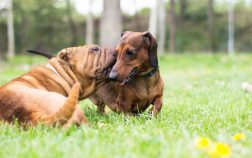Last Updated on July 12, 2022 by Cristina
Doxies come in various shapes, colors, and sizes. Here we’ll examine the question of toy dachshund vs. miniature dachshund – what exactly is the difference between them? Are toy Doxies a legitimate sub-type of this breed, are they healthy and bred properly, and should you get one instead of a miniature Doxie? Let’s find out below.
Toy Dachshund Vs. Miniature Dachshund – The Size Difference
The only real difference between these two dachshund types is the size. Purebred miniature dachshunds are expected to fall in the 8 to 11 pound weight class (3.6 to 5 kg) – significantly lighter and smaller than the much bigger standard dachshund.
Toy dachshunds, on the other hand, are supposed to be even lighter than 8 pounds or 3.6 kg. How much lighter? There is no floor to this weight class as it’s already ridiculously low anyway.

There isn’t any other major difference between toy and miniature dachshunds. In essence, just as miniature dachshunds are just standard dachshunds selected for a smaller size, so are toy dachshunds just extra small miniature pups. Neither is a mixed breed or anything like that – it’s all about selection.
How About Teacup Or Kaninchen (Rabbit) Dachshunds?
You may also encounter terms such as “teacup dachshund”, “rabbit dachshund”, or “kaninchen dachshund” – the German word for “rabbit”. Some breeders maintain that these are different sub-breeds from the toy dachshund and certain kennel clubs even list them as such. In practice, however, all these dachshund sub-types are essentially the same thing – an extra small miniature dachshund that weighs less than 8 pounds.
Toy Dachshund Vs. Miniature Dachshund – Health
The big issue most experts, kennel clubs, and breeders have with tiny dogs like the miniature dachshund is that breeding such overly small pups often comes with health risks.
On paper, toy dachshunds are supposed to be as healthy as standard and miniature Doxies – there isn’t anything different about them other than the smaller size, they haven’t been interbred with other dogs, and they aren’t supposed to carry any extra hereditary health problems.
Muttitude Dog Harness & Leash Set for Small Breeds (Extra Large, Pueblo)
So, you should expect the standard health issues from a toy Doxie as you would from a larger dachshund – Intervertebral disc disease (IVDD), Patellar Luxation, hip dysplasia, eye problems, obesity, and so on.
In practice, however, many experts insist that toy dachshunds exhibit such issues much more often than miniature and standard dachshunds – particularly when it comes to skeletal and joint issues such as IVDD and hip dysplasia. That’s largely believed to be due to two reasons – the unnaturally small size predisposes the dogs to extra health issues and toys are also more often subjected to improper breeding practices such as inbreeding.
Click Here to Get Info About:
Toy Dachshund Vs. Miniature Dachshund – Prices
On average, healthy toy dachshunds can be expected to be slightly more expensive than minis. In reality, however, the price is determined mostly by the dog’s coat type, pattern, and color, as well as by its health status, and where you’re buying it from. So, especially due to the huge coat color variety in dachshunds, prices can vary greatly and you can find pups of all sizes for anywhere between $400 and $3,000.
Which One Should You Choose? Toy Dachshund Vs. Miniature Dachshund
Given the improper breeding practices often employed with the toy, teacup, kaninchen, or rabbit dachshund, we’d generally urge people to avoid these overly small dogs. We get the appeal of such an adorably tiny dog but miniature dachshunds are also more than small enough to be unbearably cute.
That being said, whether you go for a toy or a miniature dachshund, you should always make sure that you’re getting a well-bred and healthy dog regardless. So, if you find a perfectly healthy toy Doxie, that’s obviously a good option. Just make sure to always ask for hereditary and health certificates.
FAQ’s
How much is a toy Dachshund?
Citing a price range for toy dachshunds is difficult for a few reasons. First, they are rare and are widely unrecognized by most kennel clubs. Secondly, the price is also greatly determined by their coat color and pattern. A standard black and tan short-haired dachshund will always be much less expensive than a cream dachshund, for example, whether they are toys or not. Next, geography matters too – depending on your area, state, and country, prices can vary greatly.
Lastly, it also matters where you’re getting your dachshund from and whether it’s bred properly or not. For example, pet stores and puppy mills will always give you better prices than reputable breeders but the latter is going to offer health and hereditary certificates, guaranteeing the dog’s health. In contrast, the “cheaper” dogs from pet stores and puppy mills are often bred with little regard for hereditary diseases and issues, they are raised and kept in sub-par living conditions (at best), and they are often even inbred.
Do Dachshunds bark a lot?
Doxies are considered “moderate barkers”. As scent hounds, they do have the instinct to bark when they play, chase things, or meet new people and dogs, as well as when they get scared or bored. However, with good training and socialization, they can be taught not to bark too much or to stop when you tell them to. The biggest issue is separation anxiety as dachshunds can get very loud when they become distressed for being left home alone. The best way to avoid that is to just avoid separation anxiety in the first place. All in all, Doxies can bark but they aren’t nearly as loud as Beagles, Huskies, or some other famously vocal breeds.
How big is a toy dachshund?
For a dachshund to be considered of the “toy” variety, it should weigh less than 8 pounds (3.6 kg) as a fit adult. If it’s 8 pounds or higher, it’s considered a miniature dachshund. Obviously, differentiating between the two can be difficult as you have to account for whether the dog is at its ideal body weight and isn’t overweight or underweight. Plus, figuring out whether a puppy is going to grow into a toy or miniature dachshund is also tricky.
Jordan is an animal–lover who specializes in dachshunds. He has owned and cared for dachshunds since he was a child, and his passion for these unique dogs has only grown with time. Jordan is an avid researcher and learner, and spends a large portion of his free time studying the history, behaviour, and health of dachshunds. He has a knack for training and socializing his own dogs, and loves introducing them to new experiences. When not caring for his own pets, Jordan likes to volunteer at local animal rescue shelters, helping to find homes for abandoned dachshunds. He is a true animal advocate, and dedicates his time to ensure that all animals receive the love, respect, and care they deserve.





